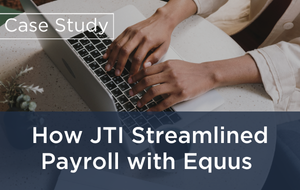HR technology should be flexible to meet the needs of employees and companies
By Cathy Koslowski, VP Technology Consultant, Equus Software
The Great Resignation is set to continue well into next year, with PwC estimating that one in five employees will switch employers. Around 35% are looking to ask for a raise with pressure higher in the tech industry. Higher pay, more job fulfillment, and wanting to be themselves are a few reasons pushing workers to change jobs.
However, those workers participating in the Great Resignation are not sitting on the sidelines. More than half switched their field of work rather than leaving the workforce entirely. And many times, this goes beyond a paycheck. MIT Sloan Management Review found that 34 million workers left because of company culture or decision-making. Oliver Wyman found that a tenth completed training for a new job. The reasons for this are complex and up to the individual. Still, in the same PwC survey, 30% said they were concerned about technology replacing their position, and 39% said they are not getting sufficient digital tools and technology training from their employer.
This shows that the Great Resignation is not just about a paycheck. While money is still the top factor in a decision, job fulfillment and being one’s true self rank just behind. Employees are looking to work somewhere that provides a sense of meaning in their work, provides them with the skills to meet future demands, and offers a work-life balance that fits their needs. HR staff and company leaders will need to upskill to meet the future of recruitment and retention.
Create an Individualized Experience
To meet employees’ expectations, HR professionals need to start with the onboarding process. Employees are considering everything from pay to work structures to environmental, social, and corporate governance (ESG) commitments and they will have questions and requirements beyond the traditional scope of the role and compensation. They will want answers immediately and personalized to them. If a company cannot or will not meet their requests, workers are more willing to walk away and will find a company that does.
One way to address this is through individualized experience packages. They want to know they will have support throughout their journey with the company. For many, this might only pertain to salary and career growth. For others, this might mean more flexibility for caregiving, allowances for daycare, or better dependent coverage. Employees might be willing to give in one area to gain in another as long as it aligns with their priorities. With a diverse workforce that has multiple needs, traditional one-size-fits-all benefits packages are no longer applicable.
More Than Benefits & Salary
Most of the Great Resignation has revolved around traditional individual needs: salary, work-life balance, work culture, benefits, and training. However, a company’s stance on ESG is increasingly becoming an issue for employees, especially younger employees. More than half of employees say that ESG issues are important in terms of a company’s transparency with 23% of employees saying a company’s commitment to environmental impact factors into their day-to-day work. These are increasingly important factors for employees, and HR professionals need to be able to address these concerns, especially through demonstrated actions by the company.
To help employees contribute on an individual level, HR departments need to appoint a senior leader outside of HR to help govern these programs.
Employee resource groups (ERGs) are important ways to get employee feedback and get a sampling of what matters to the organization in a variety of areas. Companies can also provide donation matching where they will match dollar amounts to a certain amount. This allows a company to be vested in the causes its employees care about.
HR leaders need to leverage ERGs appropriately. They cannot be seen as an afterschool club or a symbol in the organization. They are also more than networking events or reminders about healthcare enrollment. They need to empower ERGs to set goals with company leaders and organize these groups with a layer of reporting and accountability. Sponsoring ERGs and ensuring accountability is an added skill for HR. As ERGs become more prevalent in companies, this will be a very desired skill to have.
Flexibility is the New Standard
Conversations between employees and HR departments are moving from the office or at home to flexible schedules and locations that meet an employee’s needs. The pandemic has shown how the need for caregiving has changed the employee landscape. Even for employees who want to be in the office full time, a health event with a family member might require the need to work from a different location for an extended period of time. Employees want this flexibility and to work for companies that provide it.
Flexible or remote work arrangements bring a myriad of compliance, payroll, and tax issues for HR departments to manage, especially for HR professionals who previously only had to deal with in-state or bordering state requirements. If the requests are global or crossing foreign borders, HR departments will need to dedicate global mobility teams to address these issues and manage them as they occur. They will be responsible for making sure travel arrangements can be made, collaboration and socialization tools are in place, and that payroll structures are aligned for local jurisdictions.
Balancing Quantitative and Qualitative Data
Armed with more data about employees’ goals, work habits, and values, and with company ESG goals, HR departments can better improve their operations. The team can gather data on who is using what services or who is being dispatched to what assignments and identify any gaps against goals for both environmental and social sustainability. The company can use this information to course correct and improve its opportunities for employees.
Capturing, using, and interpreting this data will require upskilling the current HR team or bringing someone in with a data analytics background to keep a pulse on the data. As technology becomes a bigger touchpoint for employees, more data will be collected and analyzed. It can provide valuable insights into employee collaboration and engagement. It can also reduce time spent on low-value tasks through automation and self-serve applications.
However, do not overly rely on technology to provide collaboration and human interaction. Global mobility teams can use this for directional indicators about their employees or to provide easier ways to work. But it is important to balance this with actual interactions between global mobility and HR departments. Providing ways to connect in an inclusive way—many times in ways that technology cannot—is valuable for employees looking for more proactive ways to approach performance management, career development, and balance. Younger works are more in tune and inclined to this way of behaving.
Flexible Work, Flexible Technology
Technology should be in the service of human interaction, not a barrier to it. HR technology should be flexible to meet the needs of employees and companies. The pandemic has shown that the unexpected can happen. Being prepared with the right technology—one that is flexible and adaptable to employees—will future-proof your business and keep HR departments motivated and able to handle adversity.
Changing work habits and requirements will only accelerate. This will include hybrid and flexible work as well as ESG issues. HR departments need to continually upskill their team members. As workers become and think more global, companies that might not have had an international presence will need to evaluate everything from taxes to labor laws to governance around sustainability issues. HR professionals are becoming the face of an organization in ways beyond traditional benefits and payroll. They are leading the digital transformation of a company, and companies need to equip them with the right skills and technologies to meet constant changes in employee and employment trends and offerings.





